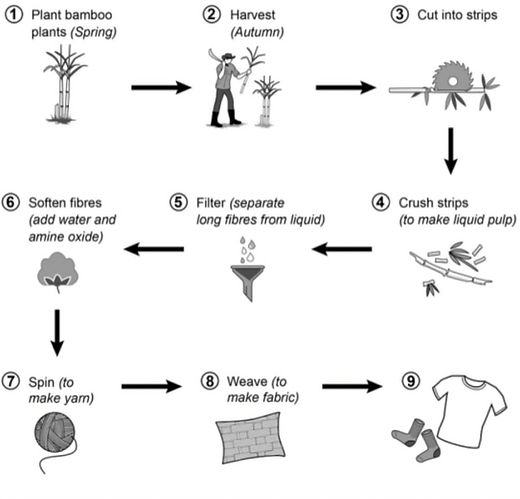
How Bamboo Fabric is Made
Writing Task One (Academic ) - IELTS Cambridge 20 ( Test 4 ), 2025
The diagram illustrates the process of producing bamboo fabric from the initial stage of cultivation to the creation of woven material. Overall, the procedure consists of nine distinct steps beginning with the planting of seeds and ending with the weaving of fabric ready for further manufacturing.
The process starts in spring, when bamboo seeds are planted, and continues until autumn, when the mature plants are harvested. Once collected, the bamboo is sliced into thin strips to allow it to be crushed more effectively, producing pulp. This pulp, together with the remaining strips, is then transferred into a filtration system, which separates the softened fibres from other components.
After the fibres have been extracted, they undergo chemical treatment with oxidized amine and hydrogen oxide to ensure they are sufficiently softened. At this point, the production phase concludes, and the fibres are ready to be processed into yarn. The fibres are spun into threads of various lengths, which are then woven to form rolls of bamboo fabric. This final material serves as the basic raw fabric for subsequent use in the textile industry.
Commentary on the grammar used:
When I wrote the first paragraph, I chose to use the present simple tense because process diagrams describe facts that are always true, not events from the past. For example, I wrote the diagram illustrates and the procedure consists of. I also used longer noun phrases to keep the style formal, such as the process of producing bamboo fabric. Instead of making separate full sentences, I shortened them into participle clauses, like beginning with… and ending with…, which made the overview more concise and academic.
In the second paragraph, I mainly used the passive voice, because I wanted to focus on the actions rather than the people doing them. For instance, I wrote seeds are planted and plants are harvested. To show the order of events, I added time expressions such as when and once, as in once collected. I also used the infinitive of purpose, for example to allow it to be crushed, to explain why something was done. Finally, I added extra detail with participle clauses, like producing pulp, which helped me avoid repeating short simple sentences.
In the third paragraph, I tried to add more variety. I started with a perfect passive clause, after the fibres have been extracted, to show that this stage was fully finished before the next step. I then switched to an active verb with they undergo chemical treatment, so the writing would not be only passive. Again, I used infinitives of purpose like to ensure they are softened, which made the explanation clear. I also included a reduced clause, ready to be processed, to keep the sentence short and smooth. Later, I returned to the passive voice with the fibres are spun and are woven, and connected the ideas with a *relative clause, which are then woven. Finally, I ended with a simple active verb serves as, followed by a precise noun phrase, the basic raw fabric for subsequent use in the textile industry, to close the process in a formal way.
Learn more terminology about this topic ↑
Rubrics:
-
Task Achievement: Covers all stages, avoids irrelevant detail (no mention of t-shirts, socks, etc.), and provides a clear overview.
-
Coherence & Cohesion: Logical paragraphing with smooth progression.
-
Lexical Resource: Uses precise process-related vocabulary (cultivation, extracted, undergo chemical treatment, spun into threads, woven to form rolls).
-
Grammar: Complex sentences handled with accuracy, variety, and concision.
Score: 9.0
Date: 19 Jul 2025
Reason:
-
Passive voice dominance → essential for process description.
-
Participle clauses & reduced relative clauses → concise and academic.
-
Complex sentences with subordination → show range (time clauses, relative clauses, infinitives of purpose/result).
-
Present simple (with perfect for sequence) → keeps it factual.
-
Clear sequencing devices (Once, After, At this point, Overall).